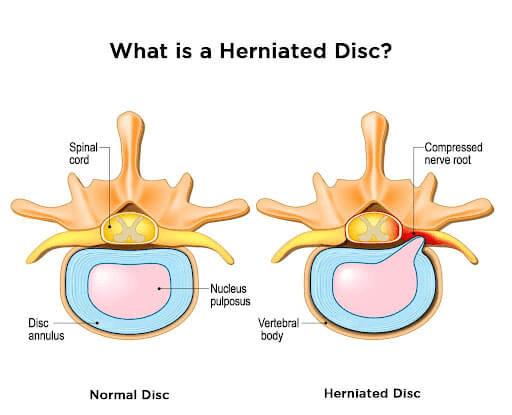
When this happens, the soft inner material of the disc can press against nearby nerve roots, leading to discomfort and potentially severe pain. The impact of slipped discs on daily life can be profound, affecting mobility, sleep, and overall well-being.
In the pursuit of relief, many individuals turn to chiropractic care as a non-invasive and holistic treatment option. Chiropractors are highly trained healthcare professionals specializing in the diagnosis and treatment of musculoskeletal disorders, including slipped discs. This article delves into the world of slipped disc treatment with chiropractic care, shedding light on how this approach can help individuals find much-needed relief and recovery.
The Anatomy of a Slipped Disc: What Happens Inside

Image Source: https://www.sapnamed.com/blog/8-tips-to-avoid-a-herniated-disc-minimizing-the-risks/
To understand the challenges posed by slipped discs, it’s crucial to grasp the intricacies of spinal anatomy. The spine is composed of a series of vertebrae stacked on top of each other, separated by intervertebral discs. These discs are akin to shock absorbers, cushioning the spine and allowing for movement. A slipped disc, or herniated disc, occurs when the tough, outer layer of a disc weakens or tears, allowing the softer inner material to protrude or bulge out of place.
When this protrusion presses against adjacent nerves, it can lead to a range of symptoms. Understanding the impact of a pinched nerve involves recognizing the intricate network of spinal nerves and their targeted influence on specific muscles and organs throughout the body. Picture your spine as a central communication hub, with different levels contributing to the supply of energy to distinct regions. A prime example is the nerve supply originating from the neck, which extends its reach to vital areas such as the head and shoulders. When a nerve becomes pinched or compressed, this intricate system can be disrupted, potentially leading to symptoms that manifest in the affected muscles or organs.
Common signs of a slipped disc include localized pain at the site of herniation, radiating pain, numbness, tingling, and muscle weakness. These symptoms can vary in severity, often depending on the location and extent of the herniation.
Chiropractic Assessment and Diagnosis: Uncovering the Root Cause
Chiropractic care for slipped discs begins with a comprehensive assessment by a chiropractor. This evaluation is crucial for understanding the unique aspects of the patient’s condition. Chiropractors employ a variety of diagnostic tools and techniques to identify the root causes of the problem. They consider the patient’s medical history, conduct physical examinations, and may use imaging studies such as X-rays or MRI scans to get a clear picture of the spinal condition.
Chiropractors take a holistic approach to diagnosis, recognizing that the spine and its components are interconnected. They evaluate not only the site of the slipped disc but also the surrounding musculature, joints, and overall spinal health. This comprehensive assessment helps chiropractors determine the most appropriate and effective treatment plan tailored to the individual’s needs.
Collaboration with other healthcare professionals, such as orthopedic specialists or neurologists, is also common in cases where additional medical expertise is required to ensure an accurate diagnosis and comprehensive care plan.
Chiropractic Techniques for Slipped Disc Treatment
Chiropractic care offers a range of specialized techniques for treating slipped discs. Central to this approach are chiropractic adjustments. These adjustments, also known as spinal manipulations, involve the application of controlled force to the affected area of the spine. Chiropractors use precise, gentle movements to realign spinal components, alleviate pressure on spinal nerves, and restore proper function.
Soft tissue therapies complement chiropractic adjustments in the treatment of slipped discs. These therapies target the surrounding muscles, tendons, and ligaments. By reducing muscle tension and promoting relaxation, soft tissue treatments contribute to pain relief and improved mobility.
Chiropractors also prescribe specific exercises and stretches designed to support the healing process. These exercises are customized to address the patient’s condition and often focus on strengthening the core and spinal-supporting muscles. Chiropractic treatment offers individuals with slipped discs an opportunity to restore spinal stability and function. This can often be achieved without the necessity for invasive procedures or medications.
Using Decompression Therapy to Treat Slipped Disc Issues
Decompression therapy emerges as an effective option for addressing slipped disc issues, providing a non-invasive and targeted approach to alleviate pain and promote healing. This therapeutic technique involves creating a controlled, gentle stretch on the spine through a specialized traction table or device. This stretching action aims to relieve pressure on the affected intervertebral disc, allowing it to retract and realign.
By creating negative pressure within the disc, decompression therapy facilitates the influx of essential nutrients, oxygen, and hydration, promoting the natural healing process. Not only does it offer relief from pain associated with slipped discs, but it also contributes to the restoration of spinal function. This non-surgical alternative provides individuals with a viable option for managing and mitigating the challenges posed by slipped disc issues, fostering a path towards improved mobility and overall well-being.
Concluding Words
Chiropractic therapy is a popular choice for individuals dealing with ongoing physical discomfort. This preference stems from its non-invasive, soothing, and quick-acting nature. You may bid your physical discomforts farewell when you see our highly trained and qualified chiropractors.
Our spine and nerve specialists can treat all these issues, which include headaches, neck discomfort, muscular pain, and lower back pain. We focus on detecting the root of the problem, structural corrections, and possibly permanently reversing the problem.
Schedule An Appointment
Our highly trained chiropractic practitioners specialize in helping people from all walks of life improve their spinal health. Visit Chiropractic First for a thorough assessment from one of our experienced chiropractors. Discover a path to better health and well-being by booking an appointment with us today!



